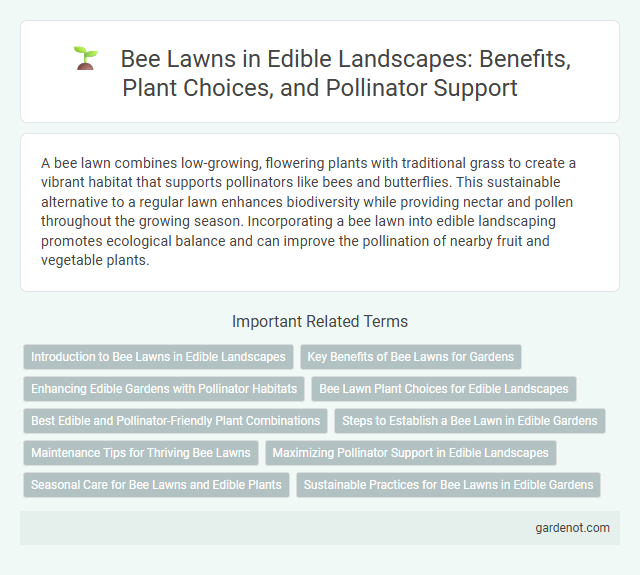A bee lawn combines low-growing, flowering plants with traditional grass to create a vibrant habitat that supports pollinators like bees and butterflies. This sustainable alternative to a regular lawn enhances biodiversity while providing nectar and pollen throughout the growing season. Incorporating a bee lawn into edible landscaping promotes ecological balance and can improve the pollination of nearby fruit and vegetable plants.
Introduction to Bee Lawns in Edible Landscapes
Bee lawns integrate low-growing, flowering plants such as clover, thyme, and self-heal with traditional grass species to create a vibrant habitat that supports pollinators in edible landscapes. These lawns enhance biodiversity, improve soil health, and provide continuous nectar and pollen sources for bees and other beneficial insects throughout the growing season. Incorporating bee lawns in edible landscapes promotes sustainable gardening practices while increasing productivity and ecological resilience.
Key Benefits of Bee Lawns for Gardens
Bee lawns enhance garden biodiversity by providing essential forage for pollinators like honeybees and bumblebees, supporting their populations and promoting healthy ecosystems. These low-maintenance lawns reduce the need for chemical fertilizers and pesticides, fostering an environmentally friendly gardening approach. Their drought-resistant qualities and ability to improve soil health further contribute to sustainable garden management.
Enhancing Edible Gardens with Pollinator Habitats
Bee lawns integrate low-growing, edible plants like clover and wild strawberries, creating vibrant habitats that attract essential pollinators such as bees and butterflies. These pollinator-friendly lawns boost fruit and vegetable yields by improving pollination efficiency within edible gardens. Incorporating native flowering species into bee lawns supports biodiversity and sustains healthy ecosystem functions crucial for garden productivity.
Bee Lawn Plant Choices for Edible Landscapes
Bee lawn plant choices for edible landscapes emphasize low-growing, nectar-rich species such as clover, thyme, and chamomile, which support pollinators while providing edible or medicinal benefits. Integrating native wildflowers like self-heal and creeping white clover enhances soil health and fosters biodiversity in sustainable food gardens. Selecting diverse bee-friendly plants ensures continuous bloom periods, maximizing habitat value for bees and other essential pollinators in edible landscapes.
Best Edible and Pollinator-Friendly Plant Combinations
Bee lawns blend low-growing edible plants like creeping thyme, clover, and chamomile with pollinator-friendly flowers such as calendula and borage to create a vibrant, sustainable turf alternative. These combinations provide essential nectar and pollen sources for bees while offering edible benefits for gardeners. Selecting drought-tolerant, nitrogen-fixing legumes alongside aromatic herbs enhances soil health and promotes biodiversity within edible landscapes.
Steps to Establish a Bee Lawn in Edible Gardens
To establish a bee lawn in edible gardens, start by selecting a seed mix rich in native nectar-rich wildflowers and low-growing clover species such as Dutch white clover, which enhances soil nitrogen. Prepare the soil by removing existing vegetation and lightly tilling to create a fine seedbed, then sow seeds evenly and press them into the soil for good contact. Maintain the bee lawn by mowing infrequently to encourage blooming, watering during dry periods, and avoiding chemical pesticides to support pollinator health and maximize honeybee and native bee activity.
Maintenance Tips for Thriving Bee Lawns
Regular mowing at a height of 2 to 3 inches promotes healthy growth and maximizes flower production in bee lawns, essential for pollinator attraction. Frequent watering during dry spells ensures soil moisture without oversaturation, supporting plant resilience and vibrant blooms. Avoiding synthetic fertilizers and herbicides preserves native flora diversity and protects beneficial insects crucial to the ecosystem balance.
Maximizing Pollinator Support in Edible Landscapes
Bee lawns integrate low-growing, pollinator-friendly plants such as clover, thyme, and self-heal to maximize pollinator support in edible landscapes. These diverse flowering species provide vital nectar and pollen resources throughout the growing season, enhancing habitat for bees and other beneficial insects. Incorporating a bee lawn increases biodiversity, improves soil health, and boosts crop pollination, resulting in more productive and sustainable edible gardens.
Seasonal Care for Bee Lawns and Edible Plants
Seasonal care for bee lawns and edible plants involves tailored maintenance practices to support pollinator health and optimize plant productivity throughout the year. In spring, mowing should be minimized to allow early bloomers like clover and wildflowers to thrive and attract bees, while light fertilization with organic compost boosts soil vitality. During summer, regular watering ensures sustained growth and flowering, and in fall, overseeding with native wildflower seeds enhances biodiversity and prepares the lawn for winter dormancy.
Sustainable Practices for Bee Lawns in Edible Gardens
Sustainable practices for bee lawns in edible gardens emphasize the use of native, pollinator-friendly plant species that provide continuous bloom throughout the growing season to support bee populations. Integrating organic soil amendments and avoiding chemical pesticides create a healthy environment that promotes biodiversity and improves soil health. Regular mowing at higher heights encourages flowering plants, enhancing nectar availability while maintaining a lush, productive lawn that benefits both bees and edible crops.
Bee lawn Infographic

 gardenot.com
gardenot.com